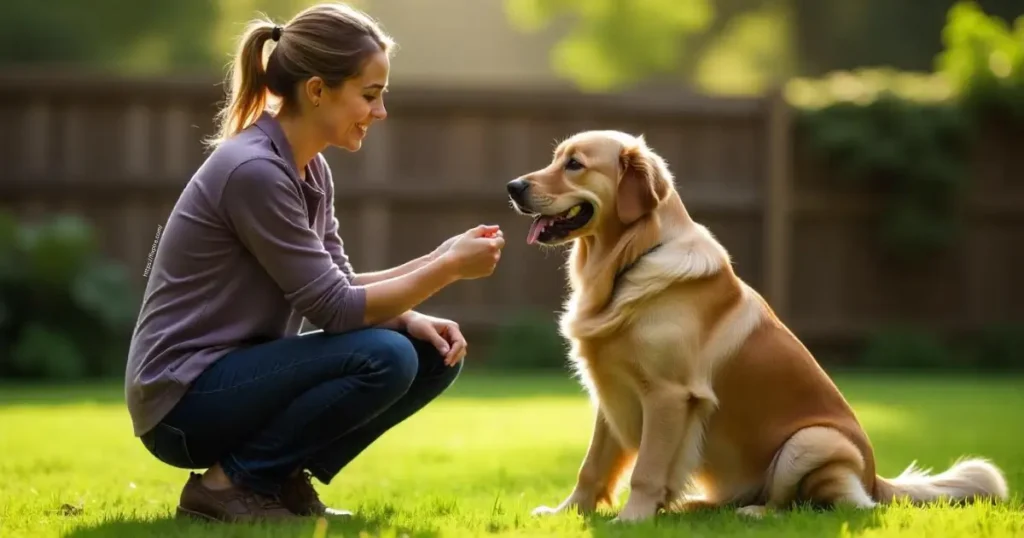Training your dog without relying on treats may seem challenging, but it is entirely possible with the right techniques. While treats can be effective motivators, overusing them can lead to dependency and health issues. Instead, you can teach your dog to obey commands through positive reinforcement, consistency, and clear communication. In this guide, you will learn how to train your dog to sit and stay without treats using simple, practical steps. Whether you are a first-time dog owner or looking to refine your pup’s skills, these methods will help you build a trusting and obedient relationship with your furry friend.

How to Train Your Dog to Sit and Stay Without Treats Easily
Training your dog without treats requires patience and consistency. It focuses on verbal praise, physical rewards (like petting), and clear commands. Here’s a comprehensive, step-by-step guide to help you begin.
Why Train Your Dog Without Treats?
While treats are a common tool in dog training, they can create a few challenges, including:
- Treat dependency: Your dog might only respond when treats are present.
- Weight gain: Excessive treats can lead to obesity or other health issues.
- Inconsistent obedience: If treats are unavailable, your dog may ignore commands.
- Budget-friendly training: Training without treats saves money in the long run.
By using verbal cues, physical gestures, and praise, you will teach your dog to obey commands regardless of whether food is involved.
Step 1: Create a Calm Environment
Before starting, choose a quiet and distraction-free area for training. This helps your dog stay focused.
- Pick a room or enclosed yard with minimal noise.
- Remove toys or distractions.
- Keep a calm tone and positive body language.
✅ Tip: Dogs respond best when they feel safe and relaxed, so avoid chaotic or loud environments during training.
Step 2: Teach the “Sit” Command Without Treats
1. Get Your Dog’s Attention:
- Stand facing your dog.
- Use a clear, firm voice and say “Sit.”
- If your dog doesn’t respond, gently place your hand on their back and lower their hindquarters into a sitting position.
2. Use Physical Praise:
- Once your dog sits, immediately praise them with affection.
- Say “Good dog!” in a cheerful voice.
- Pet them gently on the chest or behind the ears.
3. Repeat and Reinforce:
- Repeat the process several times.
- Gradually reduce the need for physical guidance.
- Your dog will begin to associate the verbal cue with the action.
✅ Tip: Stay consistent with your verbal command to avoid confusion.
Step 3: Master the “Stay” Command Without Treats
1. Use a Clear Command:
- With your dog in a sitting position, say “Stay” in a firm but calm voice.
- Make a “stop” gesture with your hand (palm facing them).
2. Increase Distance Gradually:
- Take a step back and wait a few seconds.
- If your dog stays, return to them and praise with affection.
- If they move, calmly guide them back into the sitting position.
3. Extend the Duration:
- Gradually increase the distance and duration.
- Always return to your dog before praising them.
- This reinforces the idea that staying leads to attention and praise.
✅ Tip: Practice in short sessions to keep your dog engaged and prevent boredom.
Step 4: Use Verbal and Physical Rewards
Instead of treats, use your voice, physical touch, and excitement as rewards. Dogs love praise and affection, making these effective motivators.
- Verbal rewards: Use phrases like “Good job!” or “Well done!” in an excited tone.
- Physical rewards: Gentle petting, belly rubs, or scratching behind the ears.
- Playtime: For some dogs, play is a huge motivator. Use their favorite toy as a reward.
✅ Tip: Always give rewards immediately after the desired behavior for strong reinforcement.
Step 5: Practice Consistently
Consistency is key when training without treats. Set aside 10-15 minutes daily for practice.
- Keep training sessions brief and positive to hold your dog’s interest.
- Use consistent command words and gestures each time.
- Gradually introduce distractions (like background noise) to test their obedience.
✅ Tip: Dogs learn through repetition, so patience and regular practice are essential.
Step 6: Correct Unwanted Behavior Gently
If your dog doesn’t follow the command:
- Avoid shouting or punishing them.
- Calmly guide them back into the correct position.
- Use a firm, neutral tone to repeat the command.
✅ Tip: Stay patient—it may take multiple sessions for your dog to master the commands.
Common Challenges and Solutions

1. Dog gets distracted easily:
- Use eye contact techniques to maintain focus.
- Train in a quiet space before adding distractions.
2. Dog ignores the “Stay” command:
- Decrease the distance initially.
- Gradually increase the time and distance as your dog improves.
3. Dog sits but doesn’t stay:
- Practice the “stay” command separately.
- Reward with verbal praise only when they hold the position.
✅ Tip: Be patient and consistent—progress takes time.
Benefits of No-Treat Dog Training
Training your dog without treats has several long-term benefits:
- Improved obedience: Your dog will listen regardless of food availability.
- Stronger bond: Using praise and affection builds trust.
- Better focus: Dogs trained without treats tend to focus on their owner’s voice and cues.
- Healthier weight: No-treat training helps prevent unnecessary weight gain.
✅ Tip: Verbal and physical praise is just as rewarding to dogs as food.
Conclusion
Training your dog without treats may require more patience and consistency, but it is highly effective and rewarding. By using verbal praise, physical affection, and consistency, you can teach your dog to obey commands like “sit” and “stay” reliably. Remember, building a strong connection through clear communication and positive reinforcement will lead to a well-behaved and happy dog.











